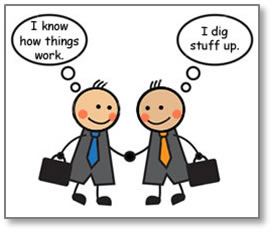

“There are only two kinds of people who are really fascinating: people who know absolutely everything and people who know absolutely nothing.” —Oscar Wilde
 GonzoBankers, one of the realities of modern banking is that there’s just a lot more to know than there used to be. Pick a topic: changing consumer behavior, new technology, industry disruptors, new payments players, vendors, products—and on and on. Nowadays, if I skip even a week of reading the trade rags and following blogs/posts/announcements, I’m already falling behind in my knowledge of what people are doing or trying to do.
GonzoBankers, one of the realities of modern banking is that there’s just a lot more to know than there used to be. Pick a topic: changing consumer behavior, new technology, industry disruptors, new payments players, vendors, products—and on and on. Nowadays, if I skip even a week of reading the trade rags and following blogs/posts/announcements, I’m already falling behind in my knowledge of what people are doing or trying to do.
One of the challenges we see facing managers is that when they are done dealing with daily issues, regulatory changes and fraud/loss challenges, all of which is never-ending and important, there’s just not a lot of energy and time left to dig into the detail of industry innovation.
I have for several years looked for the person and the role of the bank that focuses on understanding and explaining new trends, channels, disruptors, behaviors and everything related to change. This role does not easily fit into traditional organizational charts and job descriptions. Is it not really clear, for example, who should be responsible for being able to talk about successful sales through websites. Could be Sales, could be the Electronic Delivery group, could be Marketing—but it is not obvious. So, just because we’re here to help, I have come up with two new future titles for the financial institution: Chief Officer of Knowing How Things Work, and Head of Digging Up What’s Going on Out There.
I’m kidding about the job titles. Sort of.
The fact is that financial institutions need to build a stronger discipline of research (or “scouting”) that focuses on future delivery trends, well before they are mainstream. Then, there needs to be a more formal process and mechanism to decide when/how to respond. Conferences, vendors, research groups and snotty consultants are all good sources of information, but it is the bank that is accountable for translating that into a response. One trend, even if it is way on the horizon, should be looked at and discussed regularly at management meetings.
So, putting the organizational issue aside for a moment, let’s discuss five examples of questions bankers should be able to answer right now, like today.
 1. What is the best online borrowing experience a customer can have, and how close are we to it? In every planning session Cornerstone conducts and at every conference we attend, there is agreement that in five years half or more of our loan applications, and therefore half of fundings, will originate through digital channels. And we can all agree that the online marketing and fulfillment experience we can provide will determine how well we compete for that half (or more) of the business.
1. What is the best online borrowing experience a customer can have, and how close are we to it? In every planning session Cornerstone conducts and at every conference we attend, there is agreement that in five years half or more of our loan applications, and therefore half of fundings, will originate through digital channels. And we can all agree that the online marketing and fulfillment experience we can provide will determine how well we compete for that half (or more) of the business.
Question: does the management team know the best practice online borrowing experience to aim at? Is it a goal of management meetings to understand this and learn from it? It should be. There are several online lenders that have shown an impressive ability to sell and fulfill digitally and at a lower overall per-loan cost than banks. Lending Club, Funding Circle, and OnDeck are just three examples. They need to be understood. Not because they will put banks out of business, although Lending Club’s $300 million/month in originations is nothing to sneeze at. Rather, it is because they are building a delivery model that has many things banks should emulate and take advantage of. Somebody needs to have this assignment.
2. What channels do our high-profit customers use to bank with us? It’s interesting. Almost all banks know at the bank level what their transaction mix is by channel and what new account activity occurs outside of branches. They also have profitability systems that show which customers make them the most money (and, in fact, one thing that has not changed in many, many years is that 20% of customers produce at least 80% of the profit). So, has the bank put these two things together? Are the channel preferences of the people that make the bank’s profits known? Management should be able to see and plan based on this information. We very seldom, if ever, see that report. Bottom line: It is important to know what banking preferences millennials have, and we do all seem to obsess about it. But it is a deal-breaker not to know the same thing for the top-tier profitable customer.
3. What is coming to us through our ACH files? This is becoming a big payments question. We all know that PayPal uses ACH to bypass the Visa/MasterCard rails. We all know that MCX, if and when it is live at retailers, will attempt to do the same thing. Those incoming ACH files that used to be payroll and direct deposit (saving you processing costs—good) could in the not-too-distant future be chock-full of transactions that used to come through the debit rails (taking away debit revenue—not good).
4. How do our wealthiest customers manage their money? Are we at all relevant in that? In an American Banker poll, 25% of community banks said that expanded wealth management services and related fee income were very high three-year priorities. Twenty-five percent! Man, that’s a lot of wealth to go find. So, let’s take a look at the wealth management customer you are targeting. Do they use online management tools? Do they call for advice? Do they still buy face-to-face? Are they willing to pay the big stinkin’ transaction fees because they value the bank’s wisdom, or is the bank competing with TD Ameritrade for a $9 fee? Most importantly, do we know what advice they will pay for? Many bankers have the gut wisdom of front-line salespeople, but that needs to be augmented with good, hard data.
5. How does our customer debit usage compare to best practices? Are we getting the fee income we should? This is an example of a very real fee income opportunity. My colleague Bob Roth works with many of our customers on improving payments revenue, and it is astonishing how much more fee income many bankers could make by just hitting peer penetration and transaction levels. We’re often talking hundreds and thousands of dollars a year. The good news here is that Visa, MasterCard, networks and debit processors all have great reporting and information about banks’ portfolios—cool. But it is information that a lot of banks don’t ask for or read, ever—not so cool.
Bankers that can’t answer these questions need to figure out how to do so. Then they should ask and answer five more. Then repeat. We have lots of questions to share with the banks that need more. We’re here to help. Or poke.
Seriously, bankers—make this a part of your culture.
-tr
Does information management play a role in all of your technology investments?
Cornerstone Advisors can show you how to use information management to make informed technology investment decisions.
Visit our website or contact Cornerstone today to talk about smart Technology Planning.
Roger Martin in his book The Design of Business recounts telling a Canadian banker when banks were allowed into brokerage that a great target would be small businesses and entrepreneurs who tend to mix personal and business accounts. The banker asked if anyone else was doing this, and Martin said no, they’d be out in front. The banker backed away and Martin said he should have pointed to European examples. It’s hard to see how banks will compete with Vanguard and Schwab but small businesses might be a good target.